|
GAS DETECTION - HYDROGEN GAS |
|
|
 |
|
|
|
|
The exchangeable sensor X-CHANGE turns the
recalibration into a home game:
-
Delivery of recalibrated sensor
cartridges
-
Easy exchange, no specialized company
needs to come to you
-
Available for every gas type
-
At guaranteed exchange prices
-
Increased reliability (SIL2-software)
-
Important time and cost savings
The X-Change support guarantees a price based
on the consumption of the sensor capacitance.
For each uncalibrated sensor returned to AP,
you will receive a credit for the unused capacity of the sensor.
More >
|

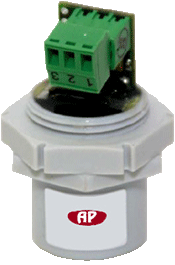 |
|
|
|
|
|
|
|
|
|
|
|
|
Hydrogen |
|
|
|
|
 |
|
|
|
|
Datasheet |
|
|
|
|
|
Legal and safety requirements
The devices are manufactured
according to the regulations and various directives such as
EN 50545, etc.
Products delivered by AP meet and even exceed the new European Standard EN
50545.
The safety features check the connected
warning devices on functionality and open circuit day and night (Level
SIL2 according to EN 50271). |
|
|
|
|
Quick and easy replacement of sensor
-
Open the housing with a screwdriver.
-
Disconnect the sensor cable and unscrew
the disused sensor head.
-
Exchange the sensor cartridge (3) and
connect the cable of the new sensor head to the PCB.
-
Close cover of the housing with the
screws (1). The recalibrated sensor is ready for use at once.
|
 |
 |
 |
 |
|
|
|
|
H2 - Hydrogen gas
Hydrogen is easily combustible, and together with
oxygen, it forms the explosive oxy-hydrogen gas.
As the name suggests, a loud bang is heard when the gas is ignited.
The waste product in the reaction consists of water vapor.
When burning hydrogen in air, in addition to water, some other
substances are formed, mainly nitrogen compounds.
In a fuel cell you can make use of the energy which is formed in the
reaction with oxygen in the air without getting other waste products
than water.
Liquid hydrogen is used in rocket engines with liquid oxygen as
oxidizer.
A great deal of hydrogen used in the petroleum industry when "upgrading"
fossil fuels.
In the Fischer-Tropsch process hydro-carbons are formed from
hydrogen and carbon monoxide.
Another major use of hydrogen exists in the production of ammonia.
In the so-called Haber-Bosch process, nitrogen and hydrogen are
mixed and subjected to high pressure and high temperatures whereby
ammonia is formed.
N2 + 3H2
 2NH3 2NH3
The ammonia can then be used for example to produce manure.
Hydrogen is also used in the production of hydrochloric acid,
methanol, and when hydrogenating fats.
Danger of explosion
In monitoring explosion danger the focus is entirely on the lower
limit of the flammable range.
This lower limit is called LEL (Lower
Explosive Limit).
Explosive gases are not explosive until they
reach a certain mixture ratio with air that is unique for each gas.
Therefore, each explosive gas its own
specific LEL level.
Detectors for explosive gases are calibrated
to give a warning for a preset alarm value, well below the LEL level.
The measure range is divided into 0 – 100%.
This means 0-100% of the lower explosive
limit.
Example:
The lower explosive limit for hydrogen is 4% by volume. 4% is equal
to 100% LEL.
This means that at concentrations below 4% by
volume there is no explosion risk.
In order to have a safety margin, Sweden has
determined as an SIS standard that in order to regard a gas as
dangerous the concentration of this gas / air mixture must exceed
25% of the LEL value.
|
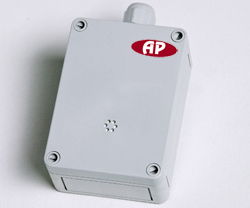
IP65,
Wall design |
|
|
|
|
|
Detector
Comb. gases |
|
|
|
|
 |
 |
|
|
|
Manual |
Datasheet |
|
|
|
|
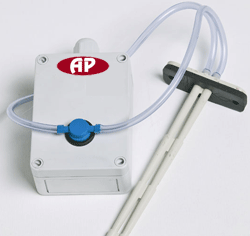
IP65, Duct design
|
|
|
|
Detektor för
brännb. gaser |
|
|
|
|
 |
|
|
|
|
Manual |
|
|
|
|
|
Address list |
Set-up |
IP |
|
|
 |
 |
 |
|
|
Modbus |
|
Protection
Class |
|
|
|
|
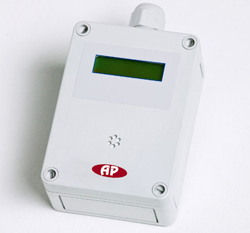
Hydrogen gas detector with display |
|
|
|
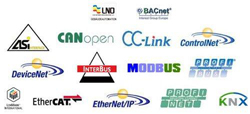
Compatible with different types of bus systems |
|
|
|
Hydrogen |
|
 |
|
Hydrogen burns/explodes in an
air/gas mixture of 4.0 till 75 vol %.
We regard 10% of the LEL to be alarm level 1
(warning alarm) and 20% of the LEL to be alarm level 2 (sharp alarm)
as appropriate alarm levels for explosive gases. |
|
Hydrogen has 4% vol = 100% LEL
Early warning alarm will then be 10% x 4% =
0.4% as alarm level 1.
Sharp alarm will then be 20% x 4% = 0.8% as
alarm level 2.
Early warning alarm will
occur at alarm level 1, which is scaled
in with 1V = 10% at 0-10Vdc control
signal.
Sharp alarm will occur
at
alarm level 2, which is scaled
in with 2V = 20% at
0-10 Vdc control signal.
These alarm levels are fed into the
controller or PLC. For detectors with relay outputs, these are
pre-calibrated to specified levels by default.
Usually the alarm levels 1 is activated at
10% of the LEL and the other preferably closer to LEL (type disaster
alert)
You can of course set different values as
alarm points.
The important thing is that the alarm levels are always activated
before LEL is reached.
When the LEL concentration is exceeded, there is no danger of explosion
because the oxygen content is too low for combustion to occur.
How many detectors are needed in a stationary system?
This must be decided from case to case
depending on the local area that you want to monitor, but as a rule
of thumb you can use the following:
One detector per 100m2,
with additional detectors at locations where leakage is likely occur.
More about
explosives and combustible gases |
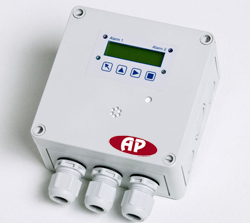
Gas Central H2C for 1-2 sensors (1 built-in) with
relay outputs for 4 alarm levels,
internal
buzzer, operator panel and display |
|
|
|
Address list |
Set-up |
|
Detector
Comb. gases |
|
 |
 |
|
 |
|
Modbus |
Modbus |
|
Manual |
|
|
|
|
|
|
|
ATEX Gas detectors are available for 2
explosion classes as follows:
Zone 1 is available with or without display .
Gas detectors for ATEX Zone 1 are located in a flameproof enclosure,
EEx d
The shell is such that ignition and
combustion within the shell of a potential explosive gas mixture is
not propagated to the explosive mixture outside the enclosure and
the enclosure can thus endure the resulting explosion pressure
without damage.
In Zone 1 ,
one can expect an explosive atmosphere to occur during normal
operation but the presence of it is relatively
short.
The equipment shall not be a source of
ignition in normal operation or when an error occurs.
Gas detectors for ATEX Zone 2 are of the
design Non-sparking EEx nA
EEx nA is a non-sparking piece
equipment.
In Zone 2, you need not count with an
explosive atmosphere to occur during normal operation, and if it
should occur, which is probably rare it is of
short duration.
The equipment shall not be a source of
ignition during normal operation.
|
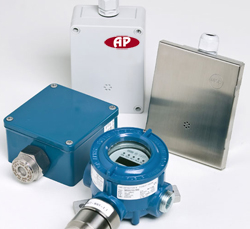
ATEX explosionproof Hydrogen gas
detectors |
|
|
|
|
|
|
ATEX |
|
|
|
|
 |
|
|
|
|
Brochure |
|
|
|
|
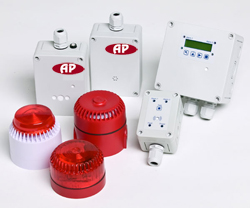
Warning lights for Hydrogen gas detectors |
|
|
|